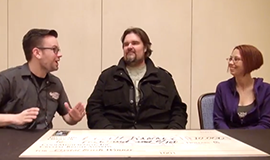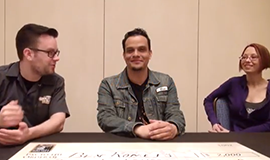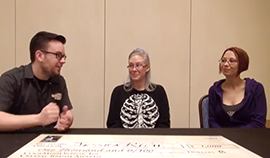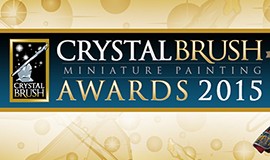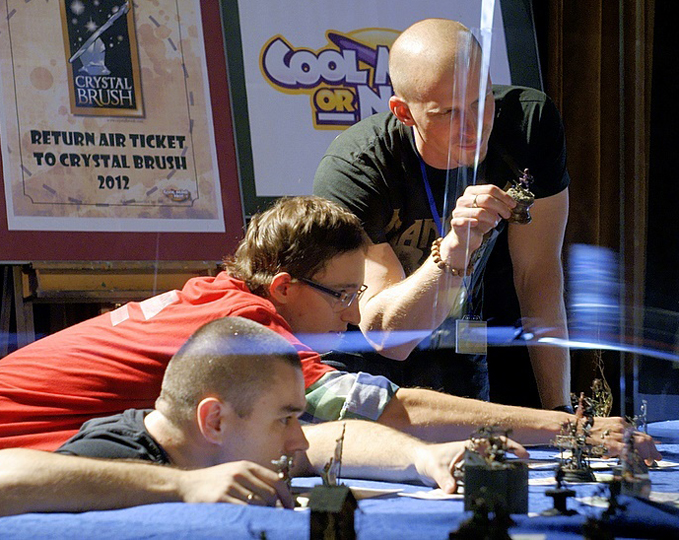Crystal Brush 2015

On Painting Competitively
Thinking about putting some of your work in a painting competition, but feeling discouraged by entries from more experienced painters? In the latest issue of Ravage magazine, Crystal Brush head judge Jen Haley discusses why you should take the chance, and offers advice on how to make your entry more competitive. Here’s an excerpt!
While I’ve helped judge many painting contests over the years, I’ve also entered many. That means I’ve done my share of grumbling about stupid judging results and arbitrary restrictions. (Sometimes half the fun of a contest is afterwards, gossiping with friends over dinner or drinks about all the things that went wrong, and what we would have done differently.) But I’ve also seen a lot of good models and worked alongside a lot of good judges. Here are some of the questions I’ve frequently been asked, both from my perspective as a judge and as a competitor.
What kinds of painting competitions are there?
Painting competitions usually fall into one of three main types. Most commonly, entries are divided into categories. Within each category a first, second, and third place winner are chosen. An overall or Best of Show is then chosen from among the category first places.
Another type of competition follows the Open System. This is technically more of an exhibition. Each entry is scored individually and awarded a Gold, Silver, or Bronze ranking. As entries are not judged against each other, but on their own merits, the numbers of each type of medal given vary from year to year. A Best of Show, and other special awards, may be chosen by the judges or by popular vote.
In the past decade, online painting competitions have become popular. These are usually hosted by games producers or hobby forums. Photos of entries are submitted by users and posted in a gallery. Winners may be selected by a panel of judges, or, more often, by popular vote from the online community. In this type of competition, the entrant’s photography skills can be as important as his or her painting skills.
The Crystal Brush Awards—what’s different about it?
Crystal Brush is uniquely structured. Half of an entry’s score comes from the members of the CoolMiniOrNot forum. This is a numerical score from 1 to 10, just like the ranking given by the public to minis in members’ personal galleries. Unlike most online contests, the photos used for voting are taken by Crystal Brush personnel. While this means that the individual entrant has little control over how the mini is presented, it also means that all the entries will be seen under the same conditions, with the same lighting and backdrop, allowing viewers to compare them more evenly.
The other half of the score (also numerical) is given by a panel of judges viewing the minis in person, just like in more traditional contests. The hands-on judging permits a more accurate gauge of an entrant’s technical skills than does judging by photographs alone. The two scores are averaged. Numerical ranking then decides the first, second, and third places in each category, as well as the top three overall winners.
Why enter a painting competition? Especially something so competitive as Crystal Brush?
Lots of people wonder why anyone would put a model in a contest knowing that world-class, highly skilled painters are going to be entering, and that the top winners will probably come from that small group. It’s a valid question. A piece that does not even make first cut may involve just as many hours and just as much thought on the part of the hobbyist as the grand prize entry. That’s a lot of effort with nothing to show for it, in terms of prizes.
But competition painting is rewarding in other ways, too. Many gamers, who know they’re never going to be fantastic painters, have a lot of fun just seeing their models in the case, especially a favorite character or army leader. “Hey, that’s my little guy! I painted him! Yeah, it’s not great, but at least mine’s not in primer. And tomorrow he’s going to kick your guy’s butt!” They don’t expect to win, but they have the courage to put their work out there for the world to see. Entering is, in itself, an accomplishment.
For some, knowing a mini will be seen by the public and judged against others is exactly the kind of pressure they need to refine their standby techniques and experiment with new ones. It’s less about winning an award and more about challenging oneself. Especially for those who paint armies, or on commission for clients, it’s easy to slip into just making it look “good enough.” A contest entry means thinking about making it look “as good as it can get.” For many people this is daunting, but for others it’s highly motivating.
And while I’ve been to many competitions where people say, “Oh, I just knew So-and-so was going to win,” the truth is…you never know. Sometimes judges make inexplicable decisions. Sometimes a model looks just okay in real life, but amazing in photographs. In a competition like Crystal Brush, especially, the “Ooo, look at that!” response to a model can outweigh a lack of technical ability. Sometimes people vastly underrate their own skills. I’ve seen many an entrant completely stunned at an awards ceremony, hearing his or her name announced.
How can I make my entry more competitive?
Every competition has its own rules and criteria, and these can vary enormously. A contest run by a company which makes tabletop fantasy games, and a contest run by a military modelers organization, may have very different opinions on what constitutes a well painted miniature. What kind of models and what styles of painting have previously scored high in the competition you’d like to enter? Those winners can give you the best clues as to what that contest is looking for in a mini, so to speak. Don’t copy a former winner, but figure out what made that model so appealing, compared to the others. And don’t create an entry which exceeds the size restrictions or doesn’t really fit into any of the categories. If your idea is too good to pass up, save it for a different competition. If the contest managers make an exception for you and accept your work, it will only annoy your fellow competitors who played by the rules.
Make your entry catch the eye. Give it a strong focal point. People are hardwired to notice things like human faces and bright lights, so a well painted expression or a source lighting effect will draw attention. Use color complements, contrasts in value, and strong lines for visual interest. An entry doesn’t necessarily need a big red flag stuck on top of it to get the judges’ attention, but if the mini is unexceptional from the distance of a foot or two, it’s likely to get lost in the crowd. In a related vein, try painting a mini that not very many people will be familiar with—or take an old favorite, something that everyone has painted the same way, and put an interesting twist on it. The unexpected novelty may get you noticed.
Always, always for an entry, pick a model you love. For every mini I’ve painted that has won an award…at a certain stage of the work, I was sick of the sight of it. Cursed the sculptor, cursed my color choices, wanted to throw it against the wall. After putting it aside for a few days (or a few months), I remembered why I’d liked it so much, and finished it happily. But if the mini doesn’t engage me from the beginning, it is almost guaranteed to remain unfinished. And if for some reason I do pick it up again later and get it to a point that can be called “done” it’s never quite as good as the winners. Most of the painters I know have had exactly the same experience. Don’t set aside all your favorite models until your skills have reached a certain level. Take a chance with one. You may be surprised by what you can do.
-
Grognard Painter
-
Nuggers
-
Grognard Painter
-
David
-
-
-
-
http://hakomike.blogspot.com hakoMike

